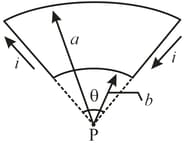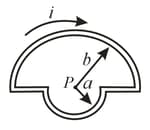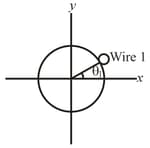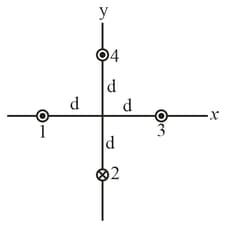Resnick & Halliday Solutions for Chapter: Magnetic Fields Due to Currents, Exercise 1: Problems
Resnick & Halliday Physics Solutions for Exercise - Resnick & Halliday Solutions for Chapter: Magnetic Fields Due to Currents, Exercise 1: Problems
Attempt the practice questions on Chapter 29: Magnetic Fields Due to Currents, Exercise 1: Problems with hints and solutions to strengthen your understanding. Principles Of Physics International Student Version solutions are prepared by Experienced Embibe Experts.
Questions from Resnick & Halliday Solutions for Chapter: Magnetic Fields Due to Currents, Exercise 1: Problems with Hints & Solutions
In the figure, two concentric circular loops of wire carrying current in the same direction lie in the same plane. Loop has radius and carries . Loop has radius and carries . Loop is to be rotated about a diameter while the net magnetic field set up by the two loops at their common center is measured. (a) Through what angle must loop be rotated so that the magnitude of that net field is (b) What is the least possible magnitude of the net field?

In the given figure, two circular arcs have radii and , subtend angle , carry current and share the same center of curvature What are the magnitude and direction (into or out of the page) of the net magnetic field at

In the figure, current is set up in a loop having two radial lengths and two semicircles of radii and with a common center What are the (a) magnitude and (b) direction (into or out of the page) of the magnetic field at and the (c) magnitude and (d) direction of the loop's magnetic dipole moment?

A wire with current is shown in the figure. Two semi-infinite straight sections, both tangent to the same circle with radius is , are connected by a circular arc that has a central angle and runs along the circumference of the circle. The arc and the two straight sections all lie in the same plane. If the magnetic field is at the circle's centre, what is

Two long straight thin wires with current lie against an equally long plastic cylinder, at radius from the cylinder's central axis. Figure a shows, in cross-section, the cylinder and wire but not wire With wire fixed in place, wire is moved around the cylinder, from angle to angle through the first and second quadrants of the coordinate system. The net magnetic field at the center of the cylinder is measured as a function of . Figure b gives the component of that field as a function of (the vertical scale is set by ), and Fig. c gives the component (the vertical scale is set by ). (a) At what angle is wire located? What are the (b) size and (c) direction (into or out of the page) of the current in wire and the (d) size and (e) direction of the current in wire



Two long straight wires are parallel and are apart. They are to carry equal currents such that the magnetic field at a point halfway between them has the magnitude of .
Should the currents be in the same or opposite directions?
How much current is needed?
The figure shows, in cross-section, four thin wires that are parallel, straight, and very long. They carry identical currents in the directions indicated. Initially, all four wires are at distance from the origin of the coordinate system, where they create a net magnetic field . To what value of must you move wire along the axis in order to rotate counterclockwise by With wire in that new position, to what value of must you move wire along the axis to rotate by back to its initial orientation? [Use ]

At a certain location in the Philippines, Earth's magnetic field of is horizontal and directed due north. Suppose the net field is zero exactly above a long, straight, horizontal wire that carries a constant current. What are the magnitude and direction of the current?
